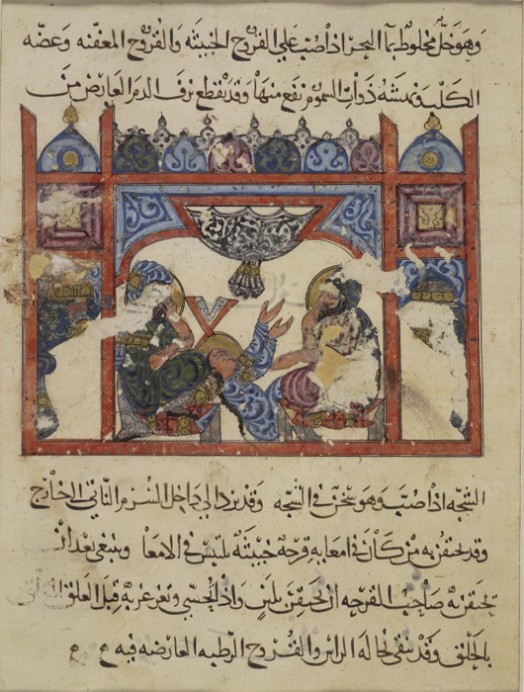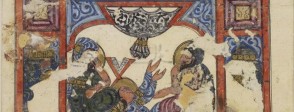
This page from a 13th century Arabic manuscript is a translation of the 1st century AD Roman medical encyclopaedia De Materia Medica. The text describes a treatment for dog bites and other poisonous bites, and stomach ulcers. The image shows two doctors administering medicine to an uncomfortable patient. Under the Abbasid caliphate, from the 8th century AD, Baghdad had become a centre of learning where scientists and doctors congregated. These scholars developed the work of the ancient Greek and Roman scientists such as Hippocrates and Galen and made medical and scientific advances. Papermaking was learned from China during the Abbasid period and manuscripts on paper became vital in recording and spreading knowledge.
The Abbasid Caliphate and the founding of Baghdad
The Abbasid dynasty was descended from ‘Abbas, uncle of the Prophet Muhammad, and seized power in AD 750 from the Umayyad Caliphate who had previously dominated the Islamic world.
The Abbasids established their capital at Baghdad in AD 762, transforming the previously small town on the Tigris river into a fortified city. It was located in a wealthy region with rich agricultural resources, particularly the three key crops of wheat, barley and dates. The outlook, beliefs and practices that led to the city’s prosperity are exemplified by the four gates to the fortified city which indicate its connections with other regions. To the north-west was the Mediterranean linking to the Byzantine empire; the north-east gate faced Persia and Central Asia and the Silk Road trading routes to China; to the south-east was the Gulf, linked to the merchant trade routes of the Indian Ocean; the south-west gate led to the route to the holy cities of Mecca and Medina.
A centre of art, literature and science
One of the early Caliphs, Harun al-Rashid, who reigned AD 786 – 809, was a generous patron of the arts and literature with great respect for scholars and poets. He was also a deeply religious man who performed the pilgrimage to Mecca regularly and waged war against non-Muslims. Harun has become a fabled ruler as he is the ruler described in the stories of the Arabian Nights
Early in the 9th century Harun established the Bayt-al-Hikmah, or House of Wisdom, which became a significant centre for learning with scholars arriving from across the world to study there. Texts arrived from Greece, Rome, India and Persia and were translated and studied by Muslim scholars. Scholars such as Al-Biruni (AD 973 – 1048) and Ibn Sina (AD 980 – 1037) made significant contributions to the development of medicine. The Materia Medica was translated in the 9th century and widely disseminated around the Arab world. Many of these texts found their way back to Europe via Islamic Spain, and were integral in the rediscovery of classical knowledge during the Renaissance.
Evidence from the Abbasids
In AD 836, the Abbasids built a new capital at Samarra after they began to feel threatened in Baghdad. This huge city was filled with magnificent and highly-decorated palaces. Images on the walls depicted scenes of leisure, such as hunting, dancing and drinking. However, Samarra was abandoned in AD 861 and Baghdad was reinstated as the capital. Baghdad was sacked by the Mongols in AD 1258, marking the end of the effective power of the Abbasids. Few buildings from the Abbasid era remain in present-day Baghdad, so we rely upon objects which have been excavated such as coins and pieces of pottery, and any delicate manuscripts which have survived. Samarra was abandoned not destroyed, so more architectural remains give us information about this pleasure city.
More information
In Our Time
Excellent and accessible BBC Radio 4 discussion programme with three experts.
http://www.bbc.co.uk/iplayer/episode/p003hyfd/In_Our_Time_The_Abbasid_Caliphs/
The Baghdad that was
Background and secondary teaching ideas on Baghdad.
http://curriculum.austinisd.org/soc_stud/hs/world_his/documents/TheBaghdadThatWas.pdf
Medieval Sourcebook: Yakut
Translated description of the city of Baghdad around AD 1000 by the Arab geographer Yâqût al-Hamawî.
http://www.fordham.edu/halsall/source/1000baghdad.asp
The True Caliph of the Arabian Nights
Hugh Kennedy article on Harun al Rashid and the Arabian Nights.
http://www.historytoday.com/hugh-kennedy/true-caliph-arabian-nights
Medieval Sourcebook: Ibn Sina
Translation of Ibn Sina (Avicenna) (973-1037) On Medicine, c. 1020 CE.
http://www.fordham.edu/halsall/source/1020Avicenna-Medicine.asp
Layla and Majnun
Example of an Abbasid poem.
http://www.bodleian.ox.ac.uk/whatson/discover/online/love-and-devotion/layla-and-majnun
Harem wall painting fragments
Transcript of the History of the World programme on the wall-paintings from Samarra – general background on the period and relationship to the Arabian Nights.
http://www.bbc.co.uk/programmes/articles/Fwl5YRmWRDLHdsXpVSDhBC/episode-transcript-episode-52-harem-wall-painting-fragments
Gold dinar of Harun al-Rashid
Coin of Harun al-Rashid.
http://www.britishmuseum.org/explore/highlights/highlight_objects/cm/g/gold_dinar_of_harun_al-rashid.aspx
More information
-
In Our Time
Excellent and accessible BBC Radio 4 discussion programme with three experts.
Source: BBC Radio 4
-
The Baghdad that was
Background and secondary teaching ideas on Baghdad.
Source: Social Education
-
Medieval Sourcebook: Yakut
Translated description of the city of Baghdad around AD 1000 by the Arab geographer Yâqût al-Hamawî.
Source: fordham.edu
-
The True Caliph of the Arabian Nights
Hugh Kennedy article on Harun al Rashid and the Arabian Nights.
Source: historytoday.com
-
Medieval Sourcebook: Ibn Sina
Translation of Ibn Sina (Avicenna) (973-1037) On Medicine, c. 1020 CE.
Source: fordham.edu
-
Layla and Majnun
Example of an Abbasid poem.
Source: bodleian.ox.ac.uk
-
Harem wall painting fragments
Transcript of the History of the World programme on the wall-paintings from Samarra – general background on the period and relationship to the Arabian Nights.
Source: bbc.co.uk
-
Gold dinar of Harun al-Rashid
Coin of Harun al-Rashid.
Source: britishmuseum.org


